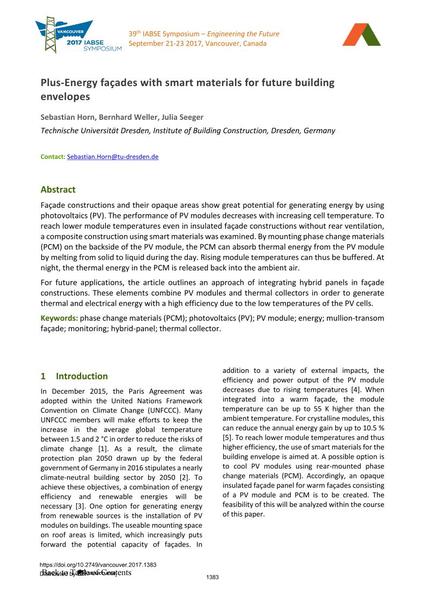Plus-Energy façades with smart materials for future building envelopes

|
|
|||||||||||
Détails bibliographiques
| Auteur(s): |
Sebastian Horn
(Technische Universität Dresden, Institute of Building Construction, Dresden, Germany)
Bernhard Weller (Technische Universität Dresden, Institute of Building Construction, Dresden, Germany) Julia Seeger (Technische Universität Dresden, Institute of Building Construction, Dresden, Germany) |
||||
|---|---|---|---|---|---|
| Médium: | papier de conférence | ||||
| Langue(s): | anglais | ||||
| Conférence: | IABSE Symposium: Engineering the Future, Vancouver, Canada, 21-23 September 2017 | ||||
| Publié dans: | IABSE Symposium Vancouver 2017 | ||||
|
|||||
| Page(s): | 1383-1390 | ||||
| Nombre total de pages (du PDF): | 8 | ||||
| Année: | 2017 | ||||
| DOI: | 10.2749/vancouver.2017.1383 | ||||
| Abstrait: |
Façade constructions and their opaque areas show great potential for generating energy by using photovoltaics (PV). The performance of PV modules decreases with increasing cell temperature. To reach lower module temperatures even in insulated façade constructions without rear ventilation, a composite construction using smart materials was examined. By mounting phase change materials (PCM) on the backside of the PV module, the PCM can absorb thermal energy from the PV module by melting from solid to liquid during the day. Rising module temperatures can thus be buffered. At night, the thermal energy in the PCM is released back into the ambient air. For future applications, the article outlines an approach of integrating hybrid panels in façade constructions. These elements combine PV modules and thermal collectors in order to generate thermal and electrical energy with a high efficiency due to the low temperatures of the PV cells. |
||||
